#BUT AT LEAST FOR 2025 I HAVE AN EASIER THEME WHICH IS
Explore tagged Tumblr posts
Text
Finished figuring out prompts for AbiDan-pril 2026!!! Idk why I did that, but I had fun hahah (I might re-do a few because they're too similar to my inspiration lists so 🤔). Still working on AbiTou-ber 2026 (assuming I will still be working on stuff for that ship in 2 years, and if I don't... well, maybe I'll have another ship I can push the prompts onto~)
I'm actually gonna' start working on sketches and stuff for AbiDan-pril soon, and I'm both excited and anxious because wow that's gonna be purely OC related art!
#air's antics#I have tentatively picked Virtue & Violence for AbiDan-pril 2026#BUT AT LEAST FOR 2025 I HAVE AN EASIER THEME WHICH IS#BONES AND BUTTERFLIES HAHAOHSDFAOF#Ugh I don't wanna go back to work cuz I just wanna be creative...#but I gotta#it's actually not been too bad today all things considered!#got a huge stress off my shoulders whwhwhw
2 notes
·
View notes
Note
Can you do a Yandere ZZZ men getting rejected. like the genshin version same reason that they just weren't their type and misunderstood. Also I saw this art about Seth older brother.
https://x.com/yougei_/status/1872198958057169238
omg pls if Seth's brother isn't something cool like that. They bring him up slightly in Harumasamasa story and I was so O.O tell me more.
Happy new year everyone! Welcome 01/01/2025!
Wise, Ben, Billy, Anton, Seth, Lycaon, Lighter, Harumasamasa - drugging, fighting, suggestive themes, I think i made it pretty gn so it could go either way, knocking out.
.

Wise:
It takes a lot of courage for someone introverted like him to speak up about his feelings. He goes through all the possible scenarios before even bringing this up, deciding that if he's going to be true than he will shoot his shot in person and not message you the dozens of deleted texts he had initially typed.
That's why when you say 'no', it's very disheartening but he's not all that scared about the consequences.
"The city is a terrible place, you know? Generic crime is the least of its worries, not when corruption is rampant in every security and business corporation that exists."
You're not really listening to his rambles, shoulders shaking as you cry through the gag in your mouth, saliva ripping down your chin. Your arms are tied tightly behind you, around the back of the chair you're sitting on and preventing you from moving freely. When Wise finally removes the blindfold from your eyes, the room around you is blurred by your constant tears. He has the generosity to wipe them for you, seeing your a concrete room with a few necessities. A bed in the corner, a small couch, a television with some movie tapes (nothing too scary), a small, wooden coffee table. You see a mini fridge ahead and the bottom of a staircase. There's no windows, though a mirror behind a plastic sheathe in front of you shows a room behind you with a toilet and possibly a shower.
Despite your spit coating your face and the hyperventilation through your nose, he tenderly cups your chin and kisses the corner of your mouth, almost shyly if it weren't for the heated glint in your eyes, "Humans can adjust to anything, with time. Don't worry, you know I'll always keep you safe, with or without your consent."
+-+-+-+-+
Billy:
"What do you mean?! It's because I'm a robot, isn't it? That's low, starlight, suuuper, suuuuuuper low."
You shake your head, smiling innocently with your hands up to indicate that that's not the case at all. "Billy, you're one of the most charming people I know-"
"- Then date me! C'mon, I promise I'll be the perfect partner for you. I'm your knight in shining armour, after all! Literally," he taps against his chest to make a 'ding ting!' sound.
You refuse the laugh that bubbles up, thinking back to all the times he has 'coincidentally' been there when you needed it most. "Yeah, about that... I wanted to talk to you..." How do you say this? 'Billy, be honest, have you been stalking me?' It is probably best to just be out with it, "Have you been following me, Billy? It's kind of weird that we keep running into each other all the time, especially whenever you seem to think I'm 'in danger'." Which could literally be you mis stepping and having him rush over to you in worry from seemingly nowhere.
As a robot, you'd think one of the better things he was capable at was lying. However, the animated nature of his gives him away too easily. He knows that all too well, deciding it was easier to just come out with the truth. Billy nervously rubs the back of his neck, "Ah, Anby said it would come across as creepy... But, you have to understand from my perspective, starlight! You're made of breakable materials. Flesh, bones, muscles, meat, it's all something that can be so easily taken advantage of."
With a sigh, you shake your head, hoping to get through to him since he obviously has the wrong idea about your species, "No, we're not that fragile. Humans-"
"-No, but, see, you are!" He's too into it now, grasping your wrist with little effort. You step back in shock, wincing at the pain, asking him to let go but he doesn't. Billy's voice is softer, the yellow lights of his eyes narrowing in on the pained expression your face so easily portrays, "I'm not even using a lot of pressure here. If you listen closely, you can hear the splitting of your bone. No, seriously! Put your ear to it," he holds up your wrist when you start to cry, looking around desperately for anyone nearby. It's late, not even a bangboo in sight.
With a loud 'snap!', your voice chokes and your crumple to your knees, except Billy doesn't let you fall to the ground. He picks you up in his arms and holds you to his cool, metal chest. He's cooing over you as you cry and cradle your wrist. You look up with such a hurtful expression, "W-Why did you do that? I need a hospital."
As if something clicks, he quickly changes mode and started fretting, holding you tighter, "Oh, shoot! Dammnit, starlight, why'd'ya make me do that? I didn't mean to go that far. Hah... Come on, let's get you home and fix you up. No more late night escapades, 'kay?"
+-+-+-+-+
Ben:
The guilt riding him when he takes you is immeasurable... He knows it's for the best. Statistically speaking, you're more likely to get hurt without him around to protect you. It's just unfortunate it had to go this route.
At the moment you were in a cage in the corner of his home office, shaking with anger and cold as he had stripped most of your clothes in punishment, your arms restrained behind your back and a blindfold to keep you more sensitive. He checks the time on the corner of his computer; it's only been 20 minutes.
Once you rejected him, he had seemed to take it in stride. It wasn't meant to be, sometimes you see a juicy fish just too late and miss it, he had to move on.
But he couldn't.
Your fiery attitude and boisterous laughter filled the calm void inside him. You are everything to him.
So one night, when he's walking down the street to clear his mind, he sees you getting off work late. When salmon travel upstream to go home, it's the bear's job to catch it. Or, something like that. With the way his mouth salivates and his body jitters in excitement, he can't help but compare you to a delicious meal, even if he doesn't want to devour you - in that sense.
Once you wake up, you fight, of course you do. He doesn't necessarily blame you for it, but, bad behaviour needs to be punished. It's when you tried to bite through his thick fur did he snap. Intentionally hurting someone is a no-go. Though, it is your first offence. Another ten or fifteen minutes and he'll let you out.
"I don't want to keep you trapped here forever. I'd like if we could go out together, too. We just need to be civil about this," he states, hoping to appeal to you with calm incitements.
Instead, you grit your chattering teeth and curse, "Fffff-uck yo-ou."
His shoulders sag, his frown deepening as he turns back to his monitor to continue working.
+-+-+-+-+
Anton:
He and his bro had spent countless hours rehearsing and none of the answers to come out were negative. So, how is it that you say anything but a resounding YES?
"I dunno," you say, shyly rubbing your arm as you avert your eyes, "I just always thought I was one of the guys. Whenever you introduced us it was always 'Anton and his two bros'."
His jaw goes slack as his brain catches up. It takes a moment of cogs turning and mathematical calculations as every moment he's ever 'friend-zone'd you comes flashing in his mind. Then, he bursts out laughing, his large hand coming to land on your shoulder, "Dude, no way! Okay, I can see where you might think that." In a completely different display of affection, one you haven't exactly experienced from a man like Anton, he runs his hand down your arm and catches your own hand in his, collecting your other as well to intertwine his fingers and hold you close. He swallows the lump in his throat, as though saying it a second time is harder than the first, - though in his defense, he and his bro had concluded that you would say yes after the first confession, this wasn't in the script. "I really do like you, (Y/n). A lot. I'd do anything for you."
Anton truly is one of the sweetest people you know. However, "I'm sorry, Anton. I think our lifestyles are just too different to begin with. But hey! I'll always be your bro!"
It's getting awkward, and you have to tug a few times before he lets go. With a small farewell, you turn on your heel to leave and give you both some time to think. He will be okay, Anton always bounces back, no problem!
Except, he doesn't. In another turn of events for someone like him, he zeroes in on a nerve near the back of your neck and hits it hard. Immediately, you collapse into his arms, unconscious.
The drill on his hip shifts from the adjustment he has to make to carry you, causing him to look down before averting his gaze with a guilty conscience, "What? Don't look at me like that, they were getting away! Besides," the smile of his is unparalleled as he stares at your sleeping face, "We just need to show them their place with us; they'll come around."
+-+-+-+-+-+
Seth:
He knows it's wrong, it's so wrong. The stalking. The lying. The manipulation. Saying something as, "Wow! What a coincidence, I didn't expect to see you here, (Y/n)." is enough to make his heart hurt with deceit. You deserve better, you deserve the word.
But you just won't listen.
You run down any empty alley to help someone who calls for help and have been scammed and attacked four times this month because of it. Yes, he knows he does it too, but, he has the skills to deal with it! It also means your money gets stolen easily and you're left with cup noodles every night for a week because you can't afford a proper meal. Not to mention your sleep schedule taking a toll because you refuse to close up shop if a customer is taking their time because you don't want to 'hurt their feelings'. Or what about that cat bite that struggled to heal because-
Seth takes a deep breath, calming his racing and distraught thoughts. His superior Zhu Yuan said it herself, "If someone I love kept putting themselves in danger, then I'd step in, no questions."
He's offered countless times to handle things, to get you to call him in any sort of emergency, and wishes so badly that you would accept his feelings rather than saying something stupid like you'd get in the way of his goals.
Why is he so scummy?
The sound of the lock to your shop is loud in the empty street. It's 11pm, you usually shut at 9 tonight. You're so tired and unconcerned that you don't even jump at his presence when you finally turn around. Your parted lips spread into a smile, tired eyes crinkling as you greet him, "Officer Seth! What a lovely surprise, are you out patrolling?" When you step forward, you notice that he's hunched in on himself, a prominent frown on his usually cheerful face, ears back and looking solemn. You come even closer, unaware of any possible signals he could be giving you to stay away, "Seth? Are you okay, what's happening?"
Instead of saying anything directly, he just walks forward until his body meets yours, collapsing into you for a hug. You let him melt in your embrace, hands coming up to rub his back gently and pet the soft tufts of his hair, murmuring how you're there for him. He has to stop his hand from shaking when he holds up the injection pen, calmly moving your hair away from your neck as though he was simply returning the favour of comfort. "I'm sorry," he mumbles into your skin, his own tired eyes closing to shut out the world, allowing it to be only him and you, "It'll only get worse if I do nothing, and it's already so bad now."
You don't have time to ask him what he means, the sudden pressure in your neck causing you to yelp. The sting comes after the shock, you try to pull away but he doesn't let you move, only continuing to squeeze you against him as your legs buckle and go numb. "Seth...?" You whisper his name, looking up with such a worried expression that he can't help but smile softly.
"No, dummy," he lifts you up when your arms go paralysed next, walking in the direction of his car, "You're supposed to scream for help when something happens."
Your lips wobble as you begin to cry, unsure of what your dear friend is planning by doing something like this. His car comes into view and you shift your head against his chest, voice weak, "Help."
"Shh," he hushes you, savouring your warmth in the quiet night, "It's too late for any of that now. You'll be safe with me."
For weeks he had been dealing with this dark, malicious substance oozing through his veins at the prospect of doing something so criminal. Now, though? Now, as he holds you and feels you and sees you in front of his, he feels like everything is suddenly right with the world. He must've been overthinking everything like usual.
+-+-+-+-+
Lycaon:
You shouldn't be so surprised to see that Lycaon has such a nice apartment. His job isn't exactly middle class and he rarely spends money outside of his fur upkeep products.
Still, as you sit the wet umbrella in its plastic sheath - curtesy of the building staff - next to the door way, you can't help but look around in awe. There's no a lot going on, a large lounge that has enough space for at least ten people, accompanied by a larger tv that is currently off. An open kitchen, hallways to the left and right, an upstairs with a balcony over half the floor plan.
And a lovely table and chairs by the floor-to-ceiling windows that looked over the city of New Eridu, which was currently pouring with rain and being illuminated by lightning.
Lycaon was standing by the lovely table, placing down the teapot down after pouring two cups before turning to face you. In an unusual turn of events, he wasn't wearing his signature uniform which you have grown accustomed to seeing, instead, he was in a simple black, buttoned down shirt and long pants. He hadn't changed the patch and belts on his face, however, which he regards with a tender touch and explanation, "Apologies, I barely had time to change before you arrived. Even though I invited you over, it's unforgivable of me."
You purse you lips at him, walking towards the set-up and stating, "You said you had feelings for me and yet you still talk to me like I'm one of your clients."
The corners of his lips tick up in a dejected smile, "I suppose it's habitual at this point. Besides, I'm still a little unsure how to go about this."
He pulls out the chair for you to sit, your body resting in the comfortable cushion on the hard seat. It takes you a moment to realise that what you said probably wasn't the best call right now. "I'm sorry, I shouldn't have said that... I was just trying to lighten the mood."
This time, his smile is a little more sincere, "Please, do not worry about it. Our previous meetings have been a tad awkward so I understand."
This relaxes you greatly, your shoulders sagging in relief. You turn your attention to the hard rain hitting the windowsill next to you, the home is warm but you're close enough for the cool air on the window to still hit you, "It's really coming down, huh?"
"Indeed," he agrees, not that he could really argue against it. Lycaon takes your cup and opens a small sugar bowl, taking a spoonful and stirring until it all dissolves, "I believe the forecast stated that it would be storming all week."
"I hope the outer circles are okay, they tend to flood easily," you mindlessly pray, accepting the teacup once he's placed it back on the saucer. You both enjoy a silence of words as you sip from your respective beverages, the rain soothing your mind.
Lycaon's ears flicker every-so-often to the sound of thunder, an endearing attribute to witness. You wonder if days like these would be common if you had said yes. It would be nice, but, you know now just isn't the right time for something like that.
Lycaon considers differently.
He clears his throat after a while, once you both had enjoyed a substantial amount of tea, "I must admit, my reasons for inviting you over are not quite... honourable."
You finally look away from the drowning city lights and to your friend, "What do you mean?"
He sets his palms in his lap and takes a deep breath, exhaling from his mouth to steady any unease, "I'm afraid I won't be allowing you to leave here, (Y/n). I've contemplated back and forth about my actions and decided that this was the most favourable outcome."
Confusion hits you before any sort of fear or anxiety, "Huh? Are you going to kill me?"
When Lycaon stiffens at that, you can't help but feel like your joke wasn't exactly off the mark. It's only until he shakes his head, almost exasperated, that you finally remember to breathe, "Goodness, no! I would never entertain such a thing. I merely mean that unless supervised by myself, you won't be leaving the premises."
You roll your eyes and play along, "Okay, so, do I have to find a hint to unlock the door? Is this a new thing for your business-" everything suddenly blurs and you double over in exhaustion. What the heck? It takes a moment to recover but when you do, you stand abruptly from the table, both hands steadying you as your body is overcome with unease, "Actually... I don't wan'na to play anymore..."
One step turns to two, and perhaps you get another half in before you're knees are collapsing beneath you and Lycaon is holding you up. He's kneeling, carefully monitoring your condition to make sure you go down as simply as the drug entices. He's talking calmly, saying something to soothe the process, perhaps, but you'll never know beyond the jumbled noise being muffled by your own hearing.
+-+-+-+-+
Lighter:
"You're not taking this seriously!" You shout at him, charging forward to get one good, hard punch to his cheek.
Lighter easily sidesteps you, grabbing a hold of your arm and twisting it backwards. You yelp in pain as he pins you down, finally doing something other than dodging your attacks, "Oh? Is that better or, do you want me to punish you more?"
His knee rubs suggestively between your thighs, your eyes tearing up in frustration as you thrash and kick. Mercifully, he retreats off of you and you you're quick to stand in another defensive position, "What is your problem?! If you're going to fight me than fight me properly!"
"I think you've forgotten that you're the one who issued this challenge," he pushes his sunglasses up his face nonchalantly, refusing to take them off despite the fact it's nighttime.
You growl and rush in to deliver a swift kick to his shin - which he artfully evades, "Only because you won't leave me alone! I'm fine by myself, I've always been fine by myself! I only ever started having troubles when you came into my life!"
He tuts and shakes his head, jumping back from another attack, "You know Big Daddy says it's not okay to tell porky pies. Little pigs like you who do get in big trouble for it."
That makes you falter, stepping back in bafflement and frankly a bit of discomfort, "What?"
Lighter is quick on his feet, stepping aside you, kicking out to trip up your ankle and catching you from behind. He spreads your legs with his own and holds your wrists behind your back, "If it weren't for me, nobody in the outer ring would look twice at you before robbing you blind and leaving your body dead in a ditch. Vulnerable city folk like you aren't exactly welcome here."
"Why go through all that trouble for someone like me, then?" You try to get out but this time, he isn't faltering, so you relinquish yourself for a moment of clarification, "If you guys hate me so much then why did you step in?"
"Because I like you. I really, fucking like you. And all I wanted was a bit of thanks and appreciation," he leans down to mumble in your ear, biting the lobe not all that gently. Again, you're pushed to the ground, his hips easily keeping you down without so much as breaking a sweat, "I win. Now, as per our agreement, this time you have to say, 'yes'."
+-+-+-+-+
Harumasamasa:
You're hands are shaking so badly that you can't hold a cup of liquid without spilling it. Your head is swimming with nausea and you seeing double of everything. How long had he been doing this without you knowing? Was this why your back didn't seem to ache the same way anymore, or your knees or your shoulders?
The door to your cell opens and you're greeted with the man himself. It's amazing how easy it is for people with power to abuse the system. "So, how're you feeling, honey? Changed your mind yet?"
"Y-You're a monster," you spit, stuttering not because you're scared or cold, but because your teeth won't stop chattering from withdrawals.
Harumasa laughs, closing the cell behind him and crouching down so he's at the height of your quivering body on the bench, "Awh, I never claimed to be a good guy! But, I wouldn't go as far as say 'monster.' Still," he reaches out and gently tucks back some of your hair, "In this scenario, you might not be wrong."
You jut your head back, smacking the brick wall with the back of your skull, 'thud!', "Fuck off."
"Oof," he winces, eyes cringing, "That had'ta hurt. C'mon, baby, just say yes and I can make all this disappear."
You're swaying from lack of balance, gods you think you might throw up, "Can't you find someone else to force your love onto?"
He stands abruptly and the motion makes you fall back, only being supported by the construction that was now the cause in your skull, "Nope! I want you. I have since I started dosing you with these." He pulls out a baggie of colourful tablets, his medication for his rare affliction. Sighing wistfully, he cradles the rainbow meds against his cheek, "If it weren't for these bad boys than I wouldn't have been able to get you do addicted to me. No one else can help you now, honey. I'm all you've got."
"Someone will come," you wish under your breath, body falling forward while you clutch your stomach in pain, "Someone will notice."
Harumasa purses his lips at you, humming in thought. With a defeated moan, he pockets the medication and stretches his arms above his head, "Welp, let's see how strong your will is after another day in the cell." Striding to one corner of the room, he grabs the little, plastic rubbish bin and brings it between your legs, "Here, you're gonna need this. The next 24 hours will not be fun for you."
You only notice he's gone when the shutting door echoes through the room, too lost in trying to keep your withdrawing body from keeling over.
#yandere zzz x reader#yandere wise x reader#yandere harumasa x reader#yandere lighter x reader#yandere lycaon x reader#yandere seth x reader#yandere anton x reader#yandere billy x reader#yandere ben x reader#yandere x reader
224 notes
·
View notes
Text
Nabi Notices (May 28, 2025)
It's been a few weeks since I did one of these. Life got busy.
In funny/not-so-funny things, I got told at a family gathering this weekend that I need to "not take things so literally" and "to look for the meaning behind words". 🤣 And besides internally dying with laughter, I only had one thought....

I'm proud of myself. I didn't say it out loud at least. They obviously don't know me well. I guess it takes more than 20 years😅.
In blog world, I've been having a fantastic time thinking about tropes and exploring tags about older shows I enjoyed. @watchthisqqq and @my-rose-tinted-glasses -> I'm still working on my "Old QL tag game" post. Apparently dates are the detail I DON'T notice, and I've watched BLs and queer media in general for so long that they're all mixed up together in my head. I probably should've just went with the first five I thought of and could confirm were pre-2020 instead of trying to actually pick favorites. I'm never good at rankings.
The Things I Noticed This Week:
I'm watching a mix of currently airing and older stuff at the moment. I definitely have not watched everything that's currently airing, and I'm finding myself binging more lately. Frankly, with the way work is currently, binging or replaying episodes is easier. The fewer decisions I'm having to make in other areas, the better. LOL.
Fabulous Fit
Since it's been a few weeks, I'm going to post a few here.
My Stubborn - Episode 5

I love both of their outfits in this scene. Black tee and jeans is pretty much a sexy staple, but beyond that -> Boat wore it extremely well. Petition to just do casual dress day at the office from here on out. It's not like we're professionals anyways. And the cloud sweater? It pops up frequently, but I want it every single time.
Pit Babe 2 -> Episode 3

Do I love this shirt with it's heart cut out? Do I hate it? I haven't decided. But I KEEP thinking about it which says...something.
Light on Me

We all know I love a good sweater, but pairing it with a fun hat to match? It's a look that brought me joy. We have enough gimmicky country themed events around here for me to know that I'd wear it if the occasion served.
And not really an entire fit, but I loved the fact that Xiao Bai wore BOTH ear cuffs while they were apart in Fight for You. The food symbolism and finger bite in the NC scene were nice bonuses.


Fascinating Find
My main deep dive this past week was into all of the symbols of The Next Prince, because it's feeding my clown car theories. Main summary -> the blue flag has an asterism on it that represents the crocodile king. A figure that is NOT the good guy in Thai folklore. I never fear the snake easily spotted in the open as much as the one hidden in the grass.

Fantastic Frame
There have been a lot of frames I've enjoyed. I will continue to reblog pretty much every variation of the Ramil/Paytai scenes from this week. As many brilliant people have discussed, their scenes feature so much good framing and lighting. It's feeding my obsession with them a wee bit. Not that it was hard to do given the characters' dynamic.

But one that I haven't discussed -> this one in Boys in Love.

The siblings all together embracing each other, because they ARE a unit no matter what problems loom behind them. And while they may have some terrible parents, they are not without support. Their support crew just comes in the teenage variety. Watching over them joyfully in the background. No judgment, just ready to hop in the car if needed and lend a helping hand on their journey.
Fun Flourish
Knock Out easily won this category this week with episode 3. I often save this category for just small, whimsical additions or something random I noticed.
But this kiss through the barrier....

And the incredible use of oil demanded attention.

Between this and IFYLITA, Director Tee knows how to shoot an oil scene is all I'm saying.
Favorite Fragment
I do not think I have ever seen the word "fuddy-duddy" in a subtitle previously, but it's a term my mother uses ALL the time. I was cackling throughout this scene in The Untamed.

I also really enjoyed this bit of dialogue from Two Husbands, One Wife as Mia contemplates what it really means to be in a poly relationship.



It was such a great way of describing that in a throuple, there are three sides that are all connected without any one of them holding more importance than the others.
My Queue for the Coming Week:
As always, this is up to whim and fancy. I'm going to watch a lot of things that are NOT on this list. But here's the ones that I'm fairly certain I'll watch.
My Stubborn (Ep 7)
Two Husbands, One Wife (Ep 8)
The Next Prince (Ep 5)
The Untamed (I've finished through episode 3. I'm just going to chip away a bit at a time on this one. There are SO many episodes 😭.)
Moonlight Chicken (Ep 2)
Love for Love's Sake (Ep 6) -> maybe. This just depends on if I get a big enough chunk of time. I can't do this one while working or doing anything else since I'm liveblogging it.
#nabi notices#my stubborn#the next prince#light on me#boys in love#pit babe 2#knock out#the untamed#two husbands one wife#sannin fufu#2 husbands 1 wife#fight for you#thai bl#taiwanese bl#japanese ql#korean bl
29 notes
·
View notes
Text
May Check-In
Hi. It's been.... almost a year since I did one of those. And until Harcourt, I hadn't posted here since October. During that time, things... happened in my personal life. I'm not going to get into it* here, but it affected greatly my ability to create and interact with IF in general. I'm getting back on the tracks, slowly returning to my original routines and circles. *maybe through more cathartic writing? after more settling.
Let's get into the longer things:
Recap of last month's progress what I've been up to since July
The 2024 To-Do List
Plan for this month
Some general lines for the rest of 2025
TLDR on the important things because it's really long: Harcourt was my announcement of some return to normalcy. I'm in the process of moving. There's going to be an announcement later this month. It's good to be back. Here's to a healthier rest of the year!
What I've been up to since July?
Some posted here, some missed (I should make some separate posts). Instead of comparing posts, I'm just recap'ing it all.
The 100% Good Assets
I created a Harlowe guide for Saves and Settings, updated the huge SugarCube Guide to match the 2.37 release, generalized the Tweego Folder for Mac users and other Twine formats, expanded the ChoiceScript to SugarCube Guide, made a Harlowe template to resemble Chapbook, updated all the SugarCube templates to 2.37, ported Cloak of Darkness to Adventuron, started Chapbook templates (Save System out, Config.style still a WIP), and finally, made a Chapbook Reference Page for convenience*. *the Guide is already chef-kiss, but the Ref Page is easier CTRL+F'ing stuff
Releases
I participated in a secret jam from the Sacred Veins collective with Svipul (an excuse to create in Twine 1/SugarCane). The theme was Righteous. This is not a happy story.
And as a final hoera in 2024, Dénantir for the Partim500. It's a mini French parser made in Donjon.FI (which had been on my to-try-list for at least two years). Some more sadness and reminiscing.
As you can see, there was a mood...
Updates
Aside from the assets listed above, obviously, the major one: the final story update of The Trials and Tribulations of Edward Harcourt. Released 6 months later than announced, but out nonetheless. Granted, the game was 90% done last October, but I dragged my feet (when IRL wasn't in the way to begin with) to deal some major coding issues that messed a lot of things.
Neo-Interactives and other Events
After the major success Neo-Twiny Jam, where we raised more money than last time (help us repeat it?), there was the Single Choice Jam, Bring Out Your Ghosts, Anti-Productivity Jam, The Bare-Bones Jam, (from here, I was less involved) Educational Jam, ShuffleComp 2024, Smoochie Jam, and the recently ended Dialogue Jam. A lot of participation overall with pretty neat entries! After a very busy, but very exciting, first full calendar year of events, we've decided to scale it back a little*. In 2025, at least, only the month-long jams will be held. *I have a huge backlog of stuff to play now... and NTJ25 is coming soon...
In other events I've helped, there was the IFCOMP for which I did Socials and Moderation, and the SeedComp! that kinda fizzled out at the end (tbf being completely MIA didn't help).
And finally, the Interactive Fiction Showcase 2024 which had so many entries. Which reminds me, I didn't announce the 2025 Showcase yet, which I should do sooner rather than later.
I did play some games, and reviewed a bunch last winter, but that fell off as well earlier this year.
Awards and other cool things that happened
I interviewed Chandler Groover for @the-rosebush-mag, following his win at the 2024 IFComp. This was such an honour to sit down with him and talk about his journey through IF.
I PROMISE I AM WORKING ON THE GAME and machina caerulea was included in the 56 edition of Indiepocalypse! A double feature~ And included with some really cool other people too!
I PROMISE I AM WORKING ON THE GAME was in a 1st-place tie for Best Use of Interactivity at the IF Short Game Showcase.
Les lettres du Docteur Jeangille won Outstanding French Game of 2024 at the IFDB Awards!! And a bunch of nominations for most of my 2024 games (though none came as close). Really proud of this. Twice in a row too! Won't happen this year, because no French Comp for me.
And David Welbourn included Not Another Sad Meal in his monthly parser walkthrough (January 2025). It's kind of wild. I've been using his amazing walkthroughs when playing many old-school parsers. And now I'm in the list! That reminds me, I need to fix some things.
~ And I think that's it? I've missed some pretty eventful periods, so a lot of stuff fell through the cracks.
It does look like I've done a lot, even during my quiet times, but it's really been more in spurs. Short periods of extreme activity and long ones of nothing (half of the summer, the whole of November, most of December, most of January, and from February until mid-April). In other words, when I had some quiet time to actually do something and when shit really hit the fan. It's been hard to balance, but I think I'm regaining my footing. April's been somewhat of a blessing in disguise.
~
The 2024 To-Do List
... has not really been followed. I haven't fixed the bugs on any of my older projects, or finished any of my WIPs (well, Harcourt, but 6 months too late). Instead, the first half was filled with unplanned game releases. On the bright side, I've fulfilled my wish of testing out new programs, or getting better at them. Well, and with Harcourt now out, I guess one thing got crossed out.
On the other hand, I haven't reviewed/played as much as I had hoped*. Even updated my website is completely out of date. Also dropped the ball on all the social media stuff. Very lacklustre year. *esp. the Neo-Interactives entries. It was important to me that every entry got some comments, to ensure everyone knew people looked at their work.
So hum... yeah. ⭐for "participating", lol.
~
The PLANtm for May
Not so much of a plan, more of what to expect this month, which... won't be much. Because the thing is: I'm moving at the end of the month. So between packing, selling, cancelling stuff here, and unpacking, opening, and probably buying things there, my IRL To-Do is arm-length at this point. It's both super stressful and a huge relief. I picked such a good time to come back, lol.
But I hope to have time to do some things. If not in updates/engaging, at least in planning for the rest of the year.
Harcourt: while the story is finished, there are still some kinks in the code/interface that can be handled better. As mentioned in the the update post, it's currently an Open Beta. There are a couple of things I'd like to add in-game. Nothing major. I don't expect the polished version to be out this month, but I'd like to make some progress on it, at minimum.
Secret Project: this will have a proper announcement later this month, but I'm currently planning a summer project for myself. It's both related to IRL and IF. Some good stuff I hope.
Really Bad IF Jam: is back by popular demands. The whole month of May, you can let out some steam by making terrible stuff. If I manage some free time, I might wing something?
Website Update: because it's a long time coming. Half a dozen games are missing, so does a bunch of new info. And it could do with a new interface.
Reconnect with the community. As a whole. I want to catch up on a lot of stuff I missed, and return notes that have been sitting in my inbox for too long.
I think if I can update the website and manage to tick off enough from planning of the secret project, I'll be pretty pleased with myself.
~
Some general lines for the rest of 2025
Normally, this is where I whip out my yearly to-do list of things I want done but probably not even manage to make a dent into it. You know the list from the start of the year, when I do my retrospective. Which hasn't happened this year either. So there's no list.
But for now, my main goal is to get back into a good healthy rhythm, where I can balance IRL stuff, IF responsibilities, and my own projects, without burn out looming or me being unable to do the things I enjoy doing. I think I'll need to make peace with my own capabilities, and stick to proper limits.
In terms of limits, the first has to be participating in events. It's not sustainable for me to try and make a game for all the IF events/game jams that catch my eye - even if I really want to or find them inspiring, and even if I can combine them. Almost all my projects have been created for or ended up submitted in a competition or jam; with ~90% of those being done on a whim/last minute. And because nothing I put out is a perfect bug-free experience, that means re-adding more to my plate with each submission. Because I still like those events very much, I need to be more realist with what I can do, and back out when things are not attainable. Like I have so far this past year. I had full planned or some form of ideas for the SingleChoice, Anti-Productivity, Educational Jam, ShuffleComp, the French Comp, the SpringThing and the Text-Adventure Jam, which all passed without a peep from me; as well as projects I've pushed for a later time for the ParserComp, IntroComp, IFComp (can't since helping organising), and EctoComp from last year. It's both been a disappointment (because I can't work on those ideas), and a relief (less stress to meet a too-short deadline!). So, for now, I'll most likely stick to just @neo-twiny-jam (for a good cause), and the Partim500. In huge part because it's only 500 words max. But also because they are the most fun experience I recall having, consistently. For any other jam, I'll restrict myself to long length (>= 1 month dev) only if I have actual time and a concrete plan (not just a vague idea/vibe - even if I want to test a new program). As for competitions, no submissions until I've finished at least one more WIP - and the entry is actually polished and tested properly (maybe I'll get better reviews now lol). That should leave me with more time to fix older projects, and complete current (and secret) WIPs. Actually actively removing stuff from my desk. For actual realsies now.
In terms of limits pt.2, IF responsibilities. I've been a part of a bunch communities, at different levels of organising, and with different amount of required efforts. Since getting more involved in the community, I've given more than 100% of myself to everything I've said yes to. It was working great for me... until I realised how much piled up. It was already too much last year, and I knew it - I couldn't keep up with most things then. Which is why I said my goodbyes to the great @interact-if last summer, and left a bunch of other discords/spaces. As mentioned above, Neo-Interactives is scaling back as well in terms of events. I had the foresight of preparing a bunch of stuff in advance (this is why @neointeractives has had scheduled posts with reminders). It's been less hectic and stressful, since not having something looming and having to untangle every 2-3 weeks. Gotta give major props to @lapinlunaire-games and @cyberpunklesbian for all their work too (esp during my breaks), they've been real rocks! As for other events, I can be pretty laissez-faire with random unranked events (like the Showcase or Really Bad IF), like posting it and let it be. But comps (and anything with more than one clear rule) require a minimum of admin and promotion*. Time and energy I need to see if I can spend (especially if I delegate) and reevaluate. *seriously... it's more work than you think it is, because it's very concentrated on specific days. It's exhausting. Rewarding too! but exhausting. That would give me a a more balanced planning at least. More time for updating stuff (the reason why yall are following me) :)
A potential path for myself in the soon future (brought to me by moving) is maybe being able to start a Ko-Fi or Support author button on itch. There's a bunch of legal mumbo-jumbo attached to that, but it's definitely something more attainable than it was while being here. It's something I'll be checking out this summer, and if possible, there will be an announcement (maybe even a new dev name?). Anyway, that's at least for late-2025-me to worry about. Also will need to find a new job first...
In any case, a slower, calmer, healthier "normal" on the horizon. And a new website! 🤞
34 notes
·
View notes
Text
Non Authorized Version
⤷ Summary: Anneliese had a plan: stay detached, stay professional, stay in control. It lasted exactly as long as it usually does. One room, one conversation, and far too many familiar mistakes. Turns out, time doesn’t fix everything, it just makes the unraveling quieter.
⤷ Author’s note: I write with this in mind this time, I guess.
⤷ Special warnings for this chapter? No explicit content, but high emotional tension throughout. Themes include anxiety responses, unresolved emotional history, and characters cornering each other in corporate spaces. Expect sharp dialogue, loaded silences, and that specific flavor of exhaustion that comes from pretending you’re fine when you’re absolutely not. First person. Narratively claustrophobic in all the intended ways.
⤷ Chapters: I, II, III, IV, V, VI, VII, VIII, IX, X, XI, XII, XIII, XIV.
⤷ Words: 2,984.
Last but not least, if you want to, you can read this on Wattpad and AO3 as well.
Chapter Three | Out Of Context
📍Brackley → Oxfordshire, United Kingdom. 2025.
Have you ever liked someone for long enough that, when you finally understood that the feeling couldn’t be sustained, you just… let time do the dirty work?
Just… waited?
Let time take its course, like it was some kind of emotional solvent, capable of dissolving what you felt?
Or have you ever found yourself loving too much?
One of those loves that takes up way too much space inside you, that grows without asking permission and then just stays there… pressed against everything else, suffocating it all?
And then… well… time and the rug—yes, the rug—ended up being your only allies. Because at some point, we get tired, don’t we?
Sweeping it all under the rug seems easier than dealing with what stays out in the open.
Pretending it’s over. That it’s part of the past now. That the feeling faded, day by day, along with everything else.
So… no.
The problem wasn’t seeing him. That wasn’t even the worst part.
The worst part was realizing that I acted exactly like I always do.
Torger calls me… and he’s never needed to try a second time.
Never.
The most I managed, with an almost miraculous effort, was to ignore the email for a few hours.
Hours.
But he didn’t need to send another one. He didn’t need to insist.
That… that’s the first mistake I always make.
Even five years later. Even after the solvent.
Even after that time.
Even after the damn rug.
And yet, there I was… again.
Staring at that face, that expression I knew far too well… with one foot inside the room.
And the other… still out.
With my brain in absolute chaos, sending a whirlwind of contradictory signals to my body… while, I wondered if I should really be there.
If I could still run.
If there was still time to come up with some last-minute excuse… and leave.
In the cowardly way I’ve always dreamed of… but never managed.
I should’ve left. Should’ve turned back. Pretended I had better things to do—which, honestly, wouldn’t even have been a lie.
I should’ve pretended that the flight and the trip here hadn’t been one long mental loop, with my mind rewinding, scene by scene, every possible way I could look detached.
Like I’ve spent the past few years trying to convince myself I was.
The professional figure. Cold. Calculated. Untouchable.
Unshakable…
The way the years taught me to fake.
The room was still the same, with a few differences, of course…
Details so subtle that maybe only I would notice them now.
A picture moved to a different spot, a piece of furniture that seemed to have been dragged a few inches, the absence of an object that used to fill some forgotten corner.
But still… untouched in its sameness.
Just like him.
And it’s curious—almost ironic—because time, yes, it did leave visible marks: small changes in the way he spoke, the way he walked, in the expressions he made without realizing it.
A trace of exhaustion where there used to be lightness.
A gaze that now seemed to carry more weight… but somehow still knew how to smile the same way.
And yet… looking at him still felt like facing something—or someone—that had simply been frozen in time.
And honestly, I don’t know how much of that is a good thing.
Or what it even means.
Comfort… or a trap?
Maybe a little of both?
“So… just the two of us?” I had barely started the sentence when his gaze landed on me.
Not just landed.
Stayed.
That kind of stare that scans.
That measures.
That calculates how long you can stay standing without wavering.
And, in that instant, I had the clear sensation that he was watching me in exactly the same way I had been watching him since the second I walked in.
Every small gesture.
Every shift of his shoulders.
Every pause… a little too measured.
“Sit down,” he said.
It wasn’t a request.
I didn’t move.
Not yet.
“No PR team? No communications manager? Not even a press officer?”
My voice came out steadier than I expected. Sharper than necessary.
A flicker crossed his face. One of those micro expressions that only someone who knows him well would catch.
Small.
But there.
“This is a direct project,” he answered. His tone controlled. Edged.
“You mean… a personal project,” I shot back, before I could filter myself.
“That’s not how these things work, Torger. I know how these books get written. They don’t start with the subject staring at the writer like this is some sort of power game.”
The air between us got heavier.
He took a deep breath. Barely noticeable. But I saw it.
“You’re here because I want you here,” he said, each word sharper than the last. “I don’t need intermediaries.”
“You mean you don’t want witnesses,” I threw back. Fast. Before my courage had time to abandon me.
Silence.
Just for a second.
Long enough for me to know I’d hit a raw nerve.
He looked away, as if fixing his gaze on some undefined point beyond me, but his clenched jaw gave him away.
And that’s when I let it out. Low. More of a confession than anything else. Something that slipped out without permission.
“Why me, Torger?”
Silence. Again.
He twirled the pen between his fingers, like someone buying time.
When he finally answered, his tone was slower. More dangerous.
“Wrong question.”
His eyes locked on mine, like the answer was right there, written on the surface of my skin.
“I vaguely remember you used to know how to ask the right questions.”
Son of a bitch. I thought.
I sat down and placed my bag in front of me, like some kind of makeshift barrier between us.
My hands were restless, and I needed a few seconds to try and pull myself together… to drag back the focus that seemed to dissolve with every new beat of my heart.
I took out my notepad and a pen from the bag, my fingers trembling too much for the motion to look natural.
I touched the paper, ran my fingertips along the lines, as if the texture could anchor me.
A new coping mechanism, less obvious than twisting a bracelet or spinning a ring on my finger, like I used to do when no one was looking.
My chest started to tighten, and the air felt thinner.
I should’ve left.
Should’ve stood up, made up some excuse, disappeared before it was too late. But… I breathed.
Forcing the air in, even with the sensation that my lungs had shrunk.
He sat down across from me, a coffee cup in his hands.
He held another one out toward me, asking, in a tone lighter than I expected, if I wanted it.
A subtle attempt to break the tension building between us.
But… I couldn’t swallow that.
Couldn’t let this conversation die in my throat, could I?
I took a deep, slow, controlled breath, placing the notebook on the table… but leaving it closed.
“You could’ve picked anyone to be your ghostwriter in Europe. Any motorsport journalist. Any biographer with an inflated ego and an enviable contact list. But you chose me. And after that, you cornered me in your office… no protocol, no intermediaries. So, tell me, Torger…”
I leaned forward, just enough to make it clear this wasn’t a rhetorical question.
“Is this a professional project… or a personal vendetta?”
His jaw tightened. But when he answered, his voice was low. Contained.
“If I wanted revenge, I wouldn’t be wasting my time offering you a contract.”
“Then why am I here?” I pressed, my voice steadier than I expected.
“Because if you think I’m going to sit here and watch you rehearse your own redemption arc… you’re seriously underestimating my patience.”
The silence after his last sentence felt almost tangible.
Heavy in a way that clung to the back of my throat.
I watched as he adjusted the cuffs of his shirt. That small, precise movement… the same as always.
The gesture he made when he wanted to appear calm. But it wasn’t.
And the smile… that crooked, half-formed smile, hanging right there in the middle, going neither up nor down.
Exactly the way he wore it when he wanted to sound ironic.
Or when he needed to pretend, he wasn’t on the verge of losing control.
“Funny…” His voice came low, skimming the edge between provocation and restrained contempt.
“I used to think you were good at reading people.”
The blood rushed to my face in an automatic, uncontrollable reaction.
The kind of flush that comes too fast to stop.
Before the silence had a chance to do even more damage, he continued:
“Just one more thing I was wrong about you, apparently.”
The words came out drier than I expected. More bitter than I’d admit.
I didn’t react right away.
Just leaned back in my chair.
Slow. Calculated.
The forced calm of someone who knows exactly the effect he’s having.
“Foreword. Chapter. Footnote…”
The pause was long. Cruel.
“Whatever makes it easier for you to erase me next time.”
The impact hit before I could even process the words.
My chest tightened in a way that felt physical, like someone had pressed a fist right against my sternum.
My breath shortened. My hands tingled, hard.
My stomach twisted so sharply it made me dizzy.
I let out a short, ugly laugh. Nervous in a way I hated.
“Well… at least tomorrow can’t be worse, right?”
He tilted his head slightly.
A small gesture.
But enough. Almost… lethal.
“Oh, it will be, Liebling.”
Right there. Exactly there.
The floor seemed to tilt.
My heartbeat lost its rhythm.
The palms of my hands went cold in an instant.
My vision… a little blurry around the edges.
I shoved the chair back harder than I should have.
Grabbed my bag from the table in a nearly clumsy motion.
My fingers were shaking. And I knew he’d notice.
I didn’t look back.
Didn’t leave space for another word.
I stood up and walked to the door with the barely disguised urgency of someone who knows they’ve got maybe five… six… seconds left before falling apart completely.
I grabbed the handle.
Pushed the door.
And I bumped into Bradley.
Standing there, looking half-surprised, as he shifted focus from the conversation he’d been having with one of Toto’s assistants.
“My dear…” he said, cutting himself off mid-sentence, probably startled by my stunned—and very likely, shocked—appearance.
With a tablet in hand, like he’d been reviewing something before walking into the room, he focused on me… then over my shoulder.
Looking straight at Toto. Inside the room.
His gaze landed on me first.
Then past me, straight to Torger, still inside.
He frowned. Small. Almost imperceptible. But I saw it.
Then he lowered his eyes to his wristwatch. Then to the tablet. Then… back to me.
“Are you two done already?”
His tone was light, but with a clear layer of confusion underneath.
It took me a second to understand.
Two… maybe more… to connect what he meant.
Almost instinctively, I glanced toward the end of the hallway, searching for the clock that used to hang there.
Of course, I didn’t find it. Different times.
My nerves were so shot I forgot I had a watch on my own wrist.
My meeting.
Had started way too early.
Way before the time the communications team had emailed me.
My stomach flipped.
For a second, I almost thought I was imagining things.
That my anxiety had scrambled the hours.
But the way Bradley raised an eyebrow… the way he glanced back toward the room: the way he took a slow breath before looking at me again.
Everything said otherwise.
“I probably mixed up my time alot,” I murmured, trying to keep my voice steady despite the dryness in my throat.
He gave me a half-smile. Crooked. The kind that said he didn’t really believe me… but wasn’t going to argue.
“Happens,” he said, still smiling, stepping aside to give me space in the hallway.
I just nodded.
Almost an automatic gesture.
And walked off.
Giving a small wave to the secretary, on my way.
As I crossed the doorway to the floor, I realized the hallway felt narrower than I remembered.
Maybe it was just my imagination.
Maybe it was my body going full defense mode.
But the air felt heavier, the lights too white… and the sound of my own footsteps way too loud for how little space I actually took up there.
I was walking too fast.
Not out of habit.
Out of a physiological urgency to get out of there.
My chest started to ache in that way I knew too well.
That familiar tightness.
The sensation of air shrinking, like my lungs had deflated in a space that used to feel big enough.
I kept my posture. Eyes straight ahead.
As if the world around me wasn’t seconds away from crumbling again.
Every meter I walked was a silent negotiation between what my body wanted to do… and what my head knew I couldn’t let happen there.
I stepped into the elevator like someone running away… but with that forced layer of dignity that tries to make it seem like I was still in control.
The reflection in the stainless-steel mirror caught me off guard.
Pale.
Dark circles deeper than I remembered that morning.
And the look… that hollow, lost look you only recognize when you’ve been through this before.
I tried to look away.
Too late.
I’d already seen it.
When the first floor doors opened, I almost tripped over my own feet.
I crossed the lobby without looking to either side.
The sound of the automatic door opening was the only thing that cut through, for a second, the buzzing that was already filling my ears.
Outside, the air felt cooler.
Not cool enough to help… but enough to remind me the world was still turning.
I picked up my pace toward the parking lot.
The weight of my bag knocking against my hip, like every step was trying to anchor me to that patch of ground that was still mine.
My hands still shaking.
My heart… still out of sync.
I tried to take a deep breath, but the air felt too dense to pull in.
It was only when I got close to the car that my phone buzzed at the bottom of my bag.
For a second, my fingers simply… didn’t respond.
It took me longer than it should have to grab it.
The screen lit up.
Maren.
“Give me a sign of life when you’re out of that room, please.”
The timing was as cruel as it was predictable.
Part of me wanted to laugh.
Part of me wanted to cry.
Neither reaction came.
Just a dry knot, sitting tight and hard in the center of my throat.
Before I could type anything, the driver opened the rear door with that measured care.
The kind of gesture you learn after seeing too many people get into cars like this… after meetings like that.
He didn’t ask if I was okay.
Not the way someone genuinely curious would.
“Miss Weiss…” His voice came low. The tone discreet.
Like any sentence above, a whisper might break me in half.
“Is your itinerary still the same?”
I nodded. Too quickly.
“Yes… just… straight to the hotel, please.”
He simply nodded back. No smile. No questions. Just held the door open until I was fully inside.
Already seated, still fumbling with the seatbelt, he spoke again.
That excessive care of someone offering a distraction… without crossing the line.
“If you’d like… I can keep the radio off.”
“Please,” I answered. Softer than I meant to.
He closed the door with the precision of someone used to handling people carrying invisible weights.
As the car pulled out of the lot, with the city blurring past outside the window, I started counting each beat of my own heart.
Trying to focus on something tangible.
Any count.
Any number I could hold on to.
Every red light felt like a provocation.
Every turn, a physical reminder that my stomach was still twisted.
When the car finally stopped, I got out before the driver could come around.
The glass door at the building’s entrance felt heavier than I remembered.
The lobby… too empty.
The walls… too bright.
I walked straight past the front desk. Ignored the stares.
Took the elevator without looking at my own reflection.
Inside the room, I dropped my bag on the floor like I was shedding a weight I didn’t want to carry anymore.
I sat on the edge of the bed, elbows on my thighs, hands in my hair, lungs still failing at finding the right rhythm.
My phone buzzed again… like the universe had chosen the worst possible moment to remind me I still existed elsewhere.
The earlier notification was still there. Waiting for me.
Maren’s message… still unanswered.
I opened the chat. Took a deep breath—or whatever counted as deep in that state—and typed with trembling fingers:
“Officially alive. And… on neutral ground for now. Thanks for worrying.”
I hit send.
And only then…
Finally let the air out for real.
For the first time since I left that office.
And the strangest… the most irritating part: was realizing that, as much as I wanted to—and more importantly, as much as I could—just quit all of this, drop the project, go home, pretend none of it had happened.
There was still, stuck somewhere deep inside me where I didn’t want to look… that old feeling.
Uncomfortable.
Almost buried: but never fully dead.
That same damn sense that, deep down… I still owe him something.
#toto wolff#toto wolff x reader#toto wolff x you#toto wolff x y/n#fanfic#fanfiction#formula one x reader#formula1#formula one imagine#you#x reader#formula 1 imagine#f1 imagine#f1 fic#f1 fanfic#totowolff#Toto Wolff#mysilverdiary
23 notes
·
View notes
Text
CDK/MoneyMAT: “SimoCoin” & Bonus Recolors

Published: 2-18-2025 | Updated: N/A SUMMARY MoneyMAT is a collection of modified objects for financial operations and storytelling in your game. The series includes functional cash clutter, as well as tools for banking, loans, and investments. #CO2MONEYMAT This is a crossover with the #CO2CDKSERIES. Cubic Dynamics by John B. Cube and Marcel Dusims forged the future with furnishings that were minimalist in design and maximalist in erudite pretension. Generations later, the company continues to produce edge-of-cutting-edge designs. Inspired by the Sims 4: Businesses & Hobbies EP (EA/Maxis, 2025), I’ve added the “SimoCoin” currency to Version 2 (V2) of the Cashpointe Set (Simmons, 2024-2025). In addition to coin, bag and sign recolors, there are three new investment items worth §1000, §3,000 and §6000 respectively. The sign recolor uses the “grilled cheese��� poster from the Nightlife EP. These items have been added to the “moneyMat” collection file and use the same trait-based autonomy as the rest of the V2 collection. As a bonus, you also get some additional banking-themed recolors (see pics below).



DETAILS All EPs/SPs or at least Nightlife EP for poster recolors. §1K - §6K | See Buy/Build Mode SimoCoin items are 94-216 poly. You need Company Expo (Mesh Pack) set (Simmons, 2024) and V2 of the Cashpointe Set (Simmons, 2024). ALL files with “MESH” in their name are REQUIRED. RECOMMENDED: When placing partitions/shelves and tables/desks/counters on the same tile, place the partition/shelves first. I recommend using this set with Object Freedom 1.02 (Fway, 2023), which includes Numenor’s fix for OFB shelves (2006), for easier use overall. DOWNLOAD (choose one) SIMOCOIN RECOLORS from SFS | from MEGA MoneyMAT COLLECTION FILE from SFS | from MEGA



BONUS RECOLORS Check out Bubblegum Bay’s ‘Godiva Bank,’ a lot I made for @chocolatecitysim’s build-a-city-challenge (BACC) (Sundays at 11:30AM EST via her Twitch Channel).
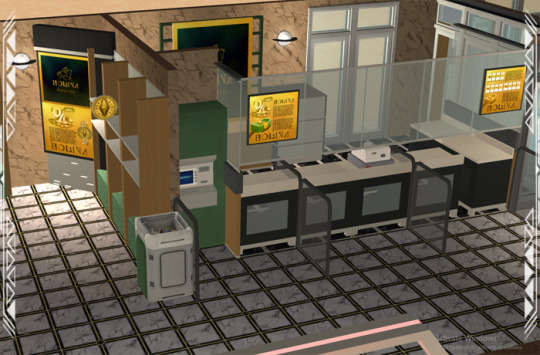
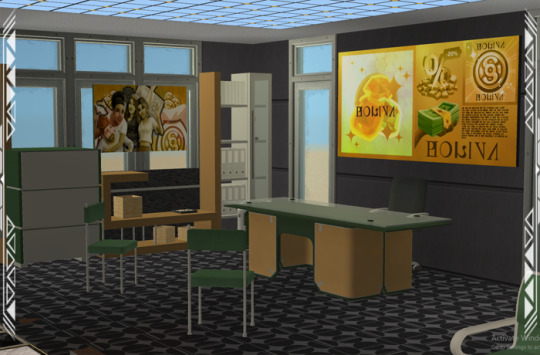

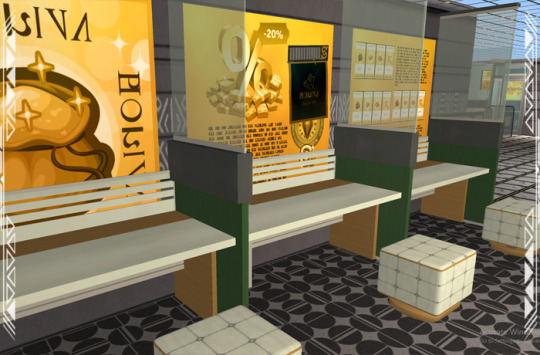
I’ve made some of these recolors available for download below.... DOWNLOAD BONUS RECOLORS (choose one) Grilled Cheese poster recolors from SFS | from MEGA You need the Nightlife EP. Expo Signage recolors from SFS | from MEGA You need the sign meshes from the Company Expo (Mesh Pack) set (Simmons, 2024) Paintings 001 and 004 recolors from SFS | from MEGA You need the painting meshes from CDK: Props 001 (Simmons, 2024) Billboards 001 recolors from SFS | from MEGA You need the horizontal, square & vertical meshes from Billboards 001 (Simmons, 2023) Poster Pack 001 recolors from SFS | from MEGA You need the square poster mesh from Poster Pack 001 (Simmons, 2022)

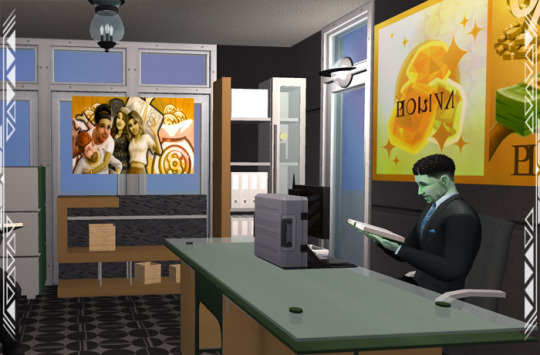
CREDITS Thanks: Simming folks on Discord, Twitch, & Tumblr. Sources: Any Color You Like (CuriousB, 2010), Beyno (Korn via BBFonts), EA/Maxis, Offuturistic Infographic (Freepik). SEE CREDITS (ALT)
53 notes
·
View notes
Text
hello and welcome to making you in fantasy life, inspired by the likes of @making-you-in-spore and all their wonderful derivatives. i take requests! here is a pinned which i will update later
please picture this music looping endlessly as you browse my blog
i make all of these on real hardware and use lumas screenshot feature to get images of them
I HAVE NOT FINISHED THE STORY OF THIS GAME. DO NOT BRING SPOILERS INTO MY NOTES.
sometimes these will not be 100% accurate due to limitations of fantasy lifes character creator -- this may involve but will never be limited to: shortened names, inaccurate body types, hair that isnt quite right, things i havent unlocked yet, and so on and so forth
none of these will be done in the new fantasy life game because A it isnt out yet and B i want to keep this simple and easy for myself. if i end up enjoying fantasy life i or want to make more detailed characters then ill make a separate tag for it
i do not take future clothing options into account for various reasons, not the least of which being because this game has massive amounts of clothing to choose from and i dont have the time for all that. maybe someday
at present (april 11th, 2025, 6:19 pm cdt) i cannot add voice clips to posts. this is because i dont have an easy way to get them from the game and dont want to have to fiddle with bullshit to get something working -- the only reason i have the avatar maker music at the ready is because its on zophars domain already. if you have any of the avatar creator voice options on-hand, send 'em my way through a filegarden link in dms or something! help make my job easier!
i have the origin island expansion pack which adds a few more customization options and, most notably, has very spoiler-heavy names for some of these options. i will NOT be making no-dlc alts of these characters because i dont have a comprehensive list of everything it adds and i do not want to also
tagging will be like this: "#made in fantasy life #avatar source: [x] #life: [x] #body type: [x] #gender: [x]" on every creation post for organization and easy searching
i add details for recreating avatars in every post unless the requester specifically says not to, in which case i will unquestioningly omit these details
apple fish
41 notes
·
View notes
Text
by Uncle Asad (Uncle_Asad)
After leaving the Salvatore School, Josie Saltzman has spent years tracking Hope Mikaelson—who has been on the run from both the Gemini twin and Triad—and trying to find a way to reach her ‘friend,’ to save her and bring her home. When Josie finds Hope in an abandoned firehouse, the tribrid faces the darkest moment of her life and is forced to confront the memories of the events and decisions that have made her who she is today.
Basically canon through 4x09, with a few tweaks that will probably be obvious. No gods, no pointless neutering of Triad and massacring of its bloodlines, and so forth!
Words: 3,719, Chapters: 1/1, Language: English
Fandoms: Legacies (TV 2018)
Rating: Teen And Up Audiences
Warnings: Major Character Death
Categories: F/F
Characters: Hope Mikaelson, Josie Saltzman, Lizzie Saltzman, Caroline Forbes, Alaric Saltzman
Relationships: Hope Mikaelson/Josie Saltzman
Additional Tags: Angst, Blood and Gore, Loss, Grieving, Martyr Complex, Deathbed Confessions, Easter, Alternate Universe - Canon Divergence, Mostly canon through 4x09, Triad (Legacies), Triad Industries, Tribrid Hope Mikaelson, No Humanity Hope Mikaelson, Dark Hope Mikaelson, POV Hope Mikaelson, Alaric Saltzman Bashing, Minor allusions to Christianity
—————
I started trying to think of Easter-themed fic ideas in early March, got half a plot and 500 words for one in the same universe as Santa Claus Is Coming to Town, and…nothing. In mid-April, with Easter fast approaching, I got another idea that seemed at least possible. But that same night, @shadowhuntermama inadvertently gave me the idea for this fic, which felt even easier to write. And it was! 2600 words in the first 24 hour and another 1000 in less than 24 more. I haven’t written like that ages—that fast, for that many words. So it was nice to see that with the right idea, I can still do it. And everyone gets a nice angsty Hosie Easter fic out of it 😂
My third completed fic of 2025.
Happy Easter!
#my fic#hosie#hosie fanfiction#hosie fanfic#hosie fanfics#hosie fics#hope mikaelson x josie saltzman#hope x josie#angsty easter fic#hope mikaelson#josie saltzman
7 notes
·
View notes
Note
Shinki adoption fic?? Please tell me everything. <3
~ @nightingaleflowlibrary
[links to the WIP game]
I have it in my WIP folder because i've talked about it so much to my boyfriend for the past *check notes* two years and a half at least apparently, that i decided to copy-paste my infodump into a Word document for easier access, but I have not technically started writing it 😆
It's set in my canon compliant/worldbuilding series. We don't have much in canon but it follows that: Gaara being called one night because Shinki is found causing some havoc and bringing him to the Kazekage Tower for the time being.
It includes :
A bunch of politics with Gaara and Kankurou trying to figure out where does Shinki come from and what happened to him, the answer to which includes some political scheming.
Some reflections about family, parenthood and parenting and Gaara and Kankurou's relationship with it, given that Gaara eventual opts for adopting Shinki, and that before that there are also both still in the "the Kazekage Clan need an heir" situation. I also think I want it to be the fic where they argue about their divergent feelings about Rasa ("He did his best with what he had" "The fuck no he didn't, he tried to kill you, several times." "Wouldn't you do it if I became a threat to the village? Isn't that your commitment to Suna?"), probably at the start, and then while they're upset with each other about it Shinki appears and they have to sort themselves out for it.
And also a lot of thing around Kankurou's relationship to children and his own childhood/youth, how seeing Shinki being cared for brings back to him the fact that it would have been possible to treat him differently when he was younger (see aforementioned arguement), how scared he is of becoming like his father and other abusive adults in his life when a vulnerable child is put into his hand, some more processing of all that, some appologies and formaive discussion with someone who has known him and seen him growin up, and the teaching that he will have to find a way because Shinki needs him, Gaara cannot do it alone, and there are things he's the only one to be able to provide for him (cue to the mandatory "Kankurou helping Shinki with his facepaint" scene).
I think I have most of the themes and important check point of the fic, but I need to seriously sit down to finish figuring out the politics (i will probably come and brainstorm that in the sand sib server), and also to have the time and will to start and finish a long fic, so I'm hoping this one is my 2025 project!
I also haven't really thoought out Baki in this, that's still uncertain. And for at least the first half Temari isn't around because until the point where the politics are a little figured out, the idea is the least people know about Shinki, the safest, but I also find it a bit disappointing that she wouldn't be here so. We'll see.
22 notes
·
View notes
Text

The end of the year is the best time of year for us self improvement obsessed girlies because the planners are out, everyone's making vision boards and its finally time to write a nice long list of New Years Resolutions and achieve precisely nothing! Nothing!
Then the end of that year comes and we start the cycle again, making lists, checking them twice, achieving absolutely nothing, staying exactly the same and sometimes worse! How exciting! :)
When I was 16 I thought I'd have my life together at 18...lol! When I was 18 I figured I'd be totally together when I was 20. I'm 20 now...I think I've genuinely gotten worse.
But this year I am determined! I have said absolutely no more, absolutely no way is another year going to pass me by and I'm going to be stuck here in the exact same place. I NEED change.
Your 20's are meant to be the 'best years of your life'!
This is probably the easiest I'm ever going to have it! I have no children, no husband and I don't pay rent yet, if I don't do it now I will never do it..I don't want this to be my life forever.
Want to know how I'm going to make this year my year? Keep reading.

About two weeks ago I coined 2024 as the year of the Glow Up and started to meticulously plan out exactly what I wanted out of it.
My main goals for 2024 are:
To Hit My Goal Weight.
To Save Up Enough Money to Move to London.
To Be 75% of my Dream Girl
There are tons of other things I want to achieve of course, but If I don't achieve those three 2024 would genuinely have been a waste of time for me.
Now a couple years ago I would've just written those two goals down, put them on a vision board and went about my business...but Oh No, not this time.

I had a nice long think about the person I wanted to be at the end of 2024, financially stable, clear skin, goal weight, ready to move in spring 2025, closer to God, found her signature scent.
Each of these goals had a wider theme:
Routine
Fitness and Body
Food
Skincare and Hygiene
Beauty & Makeup
Hair
Clothes
God
Books & Brains
Music
Budget

I fired up Notion, created a home page that had a sub page for every month and then finally I created the Overall page, which has a sub page for every Goal Category and then I broke down each goal into lots of SMART goals. (Specific Measurable Achievable Realistic Time-Based)
So my 'get down to my goal weight' goal became:
Fitness and Body:
[ ] Size 10 clothes or under and 140 lbs (I'm 5'9 with naturally big boobs so this is my ideal weight)
[ ] Hour Glass Figure, building up glutes and upper body
[ ] Maintain Goal Weight for at least 3 months
[ ] Able to Stair Machine for 10 minutes
[ ] Able to go on a full Run
[ ] Do at least one form of Excerise a day
[ ] At least one form of Excerise a day
[ ] Take the Dog on Daily Walks
Food:
[ ] Try 12 New Recipes
[ ] Learn How To Cook 4 Different Nigerian Recipes
[ ] Form Consistent Eating Routines
[ ] Eat out twice a month or less
[ ] Stay in a Caloric deficit until I reach my Goal Weight
See how much more specific this is?
Having my goals listed like this makes everything so much easier because I'm tackling multiple things at once. First I'm changing the majority of my goals to habits or tasks (things I can control) from outcomes (things I may not be able to control).
Now I know that if I do all of these things written out, staying in a caloric deficit and excising daily there's a 90% chance I'll reach my goal.
This is much more effective than writing an outcome with no plan on how to achieve it.

From here, I'll break the Goal Down Even Further, into monthly goals.
For example, to reach the goal weight Goal by the end of December, January may look like this:
Eat at 1500 calories a day or 10,500 calories a week (to allow for the high calorie company lunches I often attend as part of my work, I'll simply eat less on the other days
Go to the gym 4 times week,
Complete X Fitness plan
Go on one Dog walk a week
Meal Prep ever week.
Lose 10lbs
To Save enough Money to Move to London by the end of the year, January might look like this:
Prep for no Spend Months in Feb and March (stock up on skincare, budywash etc)
Meal plan every week
Sell £200 worth of clothes on Vinted to spend on Spring Wardrobe (I'm not buying any clothes unless I use the money I get from selling my current clothes)
Stick to Budget
My Goal to get Smarter and Stop Mindless Scrolling may look like this in January:
Read at least 1 book
Listen to 4 Podcast Episodes
Limit Social Media use to 1 hour a day
Write 6 Blog Posts
Watch one Documentary
Setting the tasks in this way also allows me to feel a sense of achievement, every month I'm able to tick off my goals which can increase my motivation, instead of writing down a list of things to do and forgetting about it until the end of the year. It also allows me to recognise when I'm going off track faster and adjust for the next month.
You see how this is better?

I was strategic in using notion because I knew that I could then use it not only to set out my goals, but as a home base, a setting point to house all the things I could use to achieve them.
Under each section I've also included a bunch of things to help me, the Food section for example has a list of my go to recipes, so that when I can't think of anything to eat and want to run over to the closest KFC I have something to choose from. The Hair section has a list of hairstyles I've done and the Pro's and Cons, the Skincare section has a list of the products I've tried, if I liked them and If they worked for me.
Each month has its own page with a section for each wider goal and a spot for me to have a monthly write up, detailing what works and what didn't work so I can change and approve the following month and prevent falling behind.
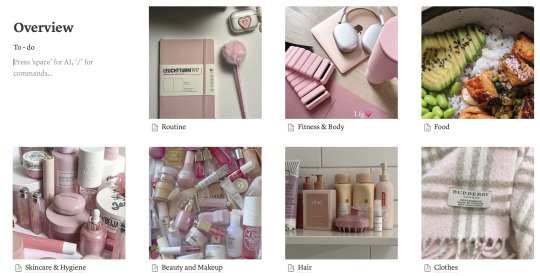
I'm determined to make this year my year so let me know if you'd like me to keep you updated, feel free to ask any questions or send them to my asks. Also let me know if you want my notion template, here's a little peak-
Till we speak again!
-hannah🤍
#level up mindset#hannahlovesyou#level up#hypergamy#black femininity#black hypergamy#hypergamous#black women in luxury#glow up#new year#new years resolution#new year new me#dreamgirl#dream girl#lovehannah
68 notes
·
View notes
Text
The one with the prompt month
First of all, I was not expecting as many people to vote on that poll as they did. With just under a day before it closes, we’re at almost 200 votes, which is…several times more than what I expected. Now, I was prepared to run this even if it only got 20 votes, so Last Days of War January 2025 is absolutely going forward now.
With that in mind, I’ve put together this post with some questions I think might need to be answered in regards to the event, though if anyone has anything else to ask, please feel free to!
The Questions:
What is a prompt month?
It’s the same principle as challenges such as Inktober, really. A calendar of prompts is released prior to the event itself, with a prompt or several prompts to each day of the challenge month.
The prompts will be kept fairly loose to ensure that they’re suitable for whatever medium people may use, but as many of them as possible will be Pacific Rim themed, taking inspiration from the first movie as well as the comic books.
The current plan (inspiration providing) is to assign three short prompts to each day in the month of January, which participants can pick and choose from, or try to use all three! This is, of course, dependent on having more than ninety prompts of a good quality, and that plan could still change. At the very least, there will be one prompt for each day. All going well, the prompt calendar will be made and posted by early November to maximise prep time.
How to take part?
There’s no sign-up necessary, so you participate simply by following along with the prompt calendar throughout the month!
Make sure to use the tag ‘#last days of war 2025’ and/or tag @lastdaysofwar on tumblr so that others can find your posts and the mod can reblog them onto the event page!
An Ao3 collection will also be made for the event so that anyone who posts over there can add their works and make them easier to locate.
Rules/Guidelines:
Honestly, it’s a bit of a free for all. The mod (hi!) is mostly here to facilitate the event by doing the prompts, answering questions and reblogging posts. The people have the power in this one.
All I will ask is that everyone be respectful to one another. If someone posts something that you don’t personally like, don’t harass them over it, just scroll past. We’re all here to have fun and enjoy the event in our own way.
Also, please try to interact with each others’ posts! Take a look through the tag to see what others have made, and make sure to let them know if you enjoy it. We all love hearing that people liked our stuff.
Further Questions?
If you have any further questions about the event, you can DM or send an ask to this account (@lastdaysofwar). The mod is more than happy to answer any questions you may have, so fire away!
There is a google form for this event that you can find here. It's quite short, and mostly to gather opinions from people who want to participate, so be sure to fill it out!
#pacific rim#pacific rim 2013#last days of war 2025#once more adding all these tags#raleigh becket#mako mori#stacker pentecost#hercules hansen#chuck hansen#hermann gottlieb#newt geiszler#chaleigh#newmann#maleigh#lady danger#striker eureka#cherno alpha#crimson typhoon#team hot dads#yancy becket#jaegers#kaiju#guillermo del toro
15 notes
·
View notes
Text
maciemace: hi everyone! i know i said i wasn't doing music for a while but... it's been a while. presenting from the vault, how to be a woman

src: Greta Isaac ♀︎ Stellar Marianas ♀︎ Darren Brown ♀︎ Simo Harjane ♀︎ Paul Becker ♀︎ special thank you to @praetoravila for creating macie & helping out with the caption!

here's a little teaser trailer i made for the macie edit i posted a few weeks ago :) below, i'll be yapping on how it came together. not quite a tutorial but just laying out my personal workflow, a kind of step-by-step application of the stuff in this mindmap.
-> MAKING OF HTBAW X MACIE
start: 2 feb 2025 | finished: 2 apr 2025
1 - song choice.
when listening to music, i'd keep an ear out if it reminds me of any particular characters. if it passes the vibe check, i'll pick apart every line to make sure it's a fit. then it goes in my giant notes app of songs & characters
late bloomer (macie's seventh album) was fresh on my mind at the time, and i quickly connected the themes of being failed by the people who were meant to protect you in the song to the album/playlist.

sneak peek of some more songs i associate with macie. leak water - bent knee ♀︎ moving on. - valerie hell
usually, the decision to make a video edit comes much later, but i knew almost instantly with this one.
2 - trim song.
i'll identify which section of the song encapsulates the character the most, and if there's certain lines i could visualise/know is present in the source material.

trim to loop, making sure the melody is resolved and the lyrics make sense where it cuts off. i usually go for verse and chorus (with exception of the jennifers edit)
3 - find clips.
i knew i didn't want to use clips from julie and the phantoms. i wanted it to be a music video macie would probably drop in-universe, and jatp footage does not fit with that vision.
at first i wanted to match the original htbaw mv: white wall fashion edit vibes. but i only found 30 seconds of footage of madison reyes that matched that description so i dropped it.


how to be a woman ♀︎ mariposa by madi (2021)
i basically went through madison reyes' entire youtube channel, screencapping shots i think might be useful. i wasn't sure for a long time of what look i was going for. i knew i wanted to include vintage barbie ads as a stand-in for amber (not like in-universe she'd say yes to starring in a vid talking shit about her lol)
once i committed to the scrapbook-y look (as with the roxy/brand new eyes vid), it came much easier.

"shot list". going through line by line to see what clips i need. most of it remained in the final video
the B-section ("remember just as long [...]") is from a different pov, so i made sure to make it visually different than the rest, but doesn't stray too far away that it's jarring.
4 - edit.
the first thing i do is lay down the lyrics and colour code each section (verse1, verse2, pre-chorus, chorus etc). they act as markers & also to break the 1 minute audio into more manageable chunks. the actual style of the text i'd leave as the final step

colour coding helps visualise which sections to work on and complete. i add extra markers within each section for certain beats and ear candy i want to highlight.
then it's basically dragging, dropping, and trimming what i collected in step 3. musicality is a huge priority for me (expanded more in mindmap). i'd stretch and squish the timings to match the song.
fav settings/tools for these scrapbook-y looking videos:
composite mode: lighter colour / darker colour
luma keyer
i like how they both give rough imperfect borders between two overlaid clips
i usually won't have enough clips/the right clips to finish it in one pass, so i'll find alternate shots and revisit the source material multiple times throughout the process (i probably rewatched all of madison reyes' vlogs at least three times over). and it's just rinse and repeat of steps 3 & 4 until i fill up the timeline.
i'd reformat the text, and there you have it, the final htbaw x macie vid :) !

thanks for reading til the end! if you could spare a little bit more time to click here -> daily clicks for palestine. and i'd appreciate if you could also spare some change for this -> isnad. thank you ! <3
6 notes
·
View notes
Text
Dogma (1999)
Seen: 10 June 2025
Summary: An abortion clinic worker sets off on a quest to stop two banished angels from reentering heaven and thus destroying the universe.

I don't want to say this movie hasn't aged well – it always was what it is – but it lives a much happier life in memory, where time can sand down the stiff performances, ungainly dialogue, inconsistent characterization, sublimated misogyny, and lazy mythology.
Which isn't to say the movie is all bad. For all its warts, it has moments of comedic brilliance. Carlin's casting as the cardinal is inspired and lends some oomph to the satire on the Church. Jason Lee's performance as Azrael is solid. Matt Damon punishing the board of directors of a golden calf themed restaurant chain for idolatry is hilarious and one of the most memorable things in the movie.
On its own terms, the movie is lampooning the way organized religions twist "good ideas" into smothering doctrines, so it's fine that the all the christian mythology doesn't really make sense or cohere – that stuff's not the point, it's just set dressing for the message that Jesus' teachings get perverted. On the other hand, the movie doesn't give us a good idea of what the non-oppressive Christian idea looks like. Instead, we get some vague ecumenicism, no real idea of what the movie thinks authentic faith is, and a gesture against ossifying ideas into beliefs.
It almost works if you squint, if only because the whole thing is done so sincerely. Despite the sarcasm and the dick and fart jokes, Dogma's sincere in its criticisms of what it sees as self-serving, hypocritical, harmful, and cynical. And its sincerity is made a bit easier to swallow by the fact the cinematography is simple. Miracles or big action moments happen with few exceptions off camera or over the course of a cut. Not leaning on the fantastical elements lets the dialogue gesture somewhat more effectively at the movie's core ideas.
But much of the humour comes from the fact that Kevin Smith still finds awe in the biological fact that boys have a penis and girls have a vagina. The sexual politics of the movie, from jokes about picking up loose women at an abortion clinic, to the clinic worker's loss of self-worth when she finds out her ovaries ovarain't, to her impregnation by divine fiat at the end of the movie... well, it's all a bit unsettling. Kevin Smith's views on women seem to be much like his views on god (at least in 1999): they are silent, inscrutable, incapable of wrongdoing, owed worship, and preferably show up to clean up the mess once the boys have had their fun.
If you can overlook that, then the movie has some fun moments and a unique idea. But it's a lot to overlook, and I don't know if I can ignore the golgothan in the room.

2 notes
·
View notes
Text
【KagePro】 Sen's KagePro Scans 💗

Notice ⚠️
Updated: 5/16/2025
Continued from my previous post
Do not repost my scans or photos without permission.
These scans aren't finalized yet.
KagePro Merch: Sidu's Postcards
Sidu's .dsd Artbook Cover Postcard

Sidu Misc Postcard

Ok I forgot which non-KagePro Vocaloid song this is. I'll correct this in a future post
Hanafuda Themed Calendar Postcard (BW Version)

Doesn't have any colour corrections applied to the scan.
Kagerou Daze -from the darkness- Cover Postcard




Kuroha/Saeru and Azami 🖤💛
1st image is the OG, and the rest are edited versions I made with colour corrections.
Played around with editing the colours! I adjusted the colours with Level Corrections.
I edited a couple different versions.
I have a few that try to bring it close to the OG colours (since the art itself is really dark)
And I have one that tries to make the art clearer so it's easier to see the details.
KagePro Merch Scans
Konoha and Ene Clear Bookmarks 💛💙


Ene and Shintaro and Konoha Clear File


Cover of spoon.2Di magazine volume 51
Ty to the KagePro Wiki. It's been super useful for figuring out which merch originated from where 🙏
Ene, Shintaro, and Konoha Clear File


Poster included with spoon.2Di magazine volume 44
Used the same description from the Wiki.
I'll play around with the colours later since the edit gets closer to the OG but is very saturated
I was trying to match the colours of the ones on the Wiki for these
Mekakushi Dan in Summer Clear File


I did scan the back covers of the clear files once, but they're not very important since it just lists "Kagerou Project" on the back.
Applied colour corrections
Just quickly adjusted the colours with Level Corrections
Kagerou Daze -in a day's- Original Material Book





Misc Rambles
I mainly focus on scanning my faves first (Kuroha, Ene, Mary, Ayano, Konoha)
9/6 and my fave gals 🖤💛💙
It's still such a shame Ayano wasn't in the Movie and didn't even cameo as Ayaki 😔
I would've wanted to see a Movie Route design for her...
...
Got the time to scan these postcards just now
There's lowkey dust on the scans, even though I wiped down my printer 😔
Oh well, at least it's not too noticeable
I should get a microfiber cloth at some point.
...
Tried test scanning some pages from the Original Materials Booklet.
I don't like that one part of the page is blurry 😭
I think I know why it's happening, but the trial and error is kinda :/
Especially when my scanner scans so slow and takes 2.5 - 3 minutes to scan a single page 🐢
Maybe cuz the pages on the side of the cover are most likely easier to scan?
For example, the Ene page has the rest of the book's pages underneath it
I may need to get something heavier to lay the book down flat...
...
God it bothers me cuz there's a shadow over Mary's page near where the book binding is???
Since I put the entire book down (or just a few pages), the scanner lid can't be closed completely
When the scanner lid can't be closed completely, it creates some uneven lighting
It has a gray/black background instead of white.
And also cuz the book doesn't completely touch the scanner glass.
The book lifts off the scanner a little
So I had to get something heavier like my Mekakucity V's Blu-Ray box to sit on the book to flatten it more
...
I think putting down a single page is really risky, cuz then, the book has to be held up by something while the scanner lid is closed.
It'd be really easy to accidentally damage the book like that and accidentally bend pages, so I won't try.
I'll try scanning the rest some other time though, like I scanned enough today.
I know a sheet of glass (or something similar) is usually used to hold a book down but I don't think I have something like that…
#kagepro#kagerou project#kagerou daze#kuroha#ene#enomoto takane#saeru#konoha#kozakura mary#azami#kisaragi shintaro#konoene#konoha x ene#kagerou daze in a day's#mekakushi dan#kagemerch#sidu#official art#my scans#stepswordsen scans#artbook scans#sen scans#sen's scans#I think I got a lot done today since I scanned like 25+ pages which includes retries to rescan stuff better so there's less dust#I really wanna descreen my scans cuz the Moire texture is so noticeable on dark illusts like Saeru's .dsd/V art and the LN 7 art#Eventually ofc. I'd have to look into it and try to figure out how it works first
4 notes
·
View notes
Text
˚꩜。 LAST YEAR I ABSTAINED : A PRIVATE BLOG FOR GETŌ SUGURU FROM JUJUTSU KAISEN . ORIGINALLY CREATED BY GEGE AKUTAMI, HERE CONCEPTUALIZED BY MARINA. DARK THEMES & TRIGGERING CONTENT MAY BE EXPLORED, INTERACT AT YOUR OWN DISCRETION. : THIS YEAR I DEVOUR.
AFFILIATION ⸻ @phys1cian
꩜ WELCOME TO CURSEAT! this is an independent roleplay blog for GETŌ SUGURU from jujutsu kaisein, established in 2025. i'm MARINA (25+ / WHITE BRAZILIAN, SHE/HER), who has been around the rpc since 2013 and recently came back. other blogs you can find me in are @legashe (REY SKYWALKER, STAR WARS), @trajedis (OBI-WAN KENOBI, STAR WARS) and @godefy (LUCIFER, 'ORIGINAL' CHARACTER).
꩜ ALL CONTENT HERE IS MY OWN — though i do not own getō, all writing, graphics, headcanons and so on here are my own. most of the content here will be canon-based, but i will be playing around with concepts and ideas around my own personal whims.
꩜ COMMON RPC ETIQUETTE APPLIES, as previously mentioned i have been on the rpc on and off for a very long time. i don't feel the need to dwell or go on detail on what is and isn't accepted on this blog or on the dashboard. to be clear: don't be a bigot, don't steal my things, don't godmod, etc.
꩜ THIS BLOG IS PLOT-ORIENTED, meaning that most in-character interactions will be discussed beforehand, even those with canonically established relationships. i tend to write longer replies and it is easier when there's at least some semblance of development. a little bit goes a long way!
꩜ THIS BLOG IS MEANT FOR A MATURE AUDIENCE , given the nature of the animanga as well as my own age and the age of the characters, mature themes will be present and explored. for this reason, this blog is 21+. please do not follow if you are underage.
꩜ I RESERVE THE RIGHT TO UNFOLLOW at any given moment and for any reason. most of the time there isn't one. i give you the right to unfollow me as well, either soft or hard blocking is fine. i won't bother you about it and i expect to not be bothered about it either. it's not that deep, we are all strangers on the internet writing.
꩜ I AM NOT INTERESTED ON DRAMA, nor do i participate on callout culture unless absolutely necessary, which in my many years in the rpc i have found it rarely is. my time on the dashboard is limited and i'd rather spend it writing than worrying about vagues, petty disputes or whatever else.
꩜ ETC : i do not mind duplicates following me, but i probably won't follow first. this is a vast fandom with vast interpretations and portrayals, and each one is unique. i do not see a problem with multiple sugurus existing. i am slow when replying — i work and have other blogs and sometimes just don't have the muse. i will never expect you to reply quickly nor demand anything. we are all just vibing and that's the beauty of it!
1 note
·
View note
Text
A Year of Animation Day 29: LoK S1E9-12
Date: January 29, 2025
Day: 29
Content Watched: The Legend of Korra, Season 1, Episodes 8-12
Year: 2012-2014
Rating: TV-PG
Run Time: 92 mins.

When I reviewed ATLA, I talked about the framing used in the shots. I haven't noticed as much in Korra, perhaps because there's less, or perhaps because I've been inattentive. But there are some scenes in these episodes where characters are framed by tunnels. We also have more great facial expressions--Lin when Pema is going into labor and Iroh's when he finds out that Bolin is not a metalbender. I also really like the camera angles when Korra is sliding down the snow after she escapes from Tarlock.
My favorite bit of animation is probably when Korra is bending underwater and comes up in a water spout. It just looks cool. But I also like how Iroh uses his firebending as a sort of parachute to keep himself in the air (and considering he's played by Dante Bosco, hearing him thank Aang's statue for being there for him is perfect.)
I do feel like the emptiness of the city is most apparent in these scenes. There are ambulances and people fighting in mechtanks, but no civilians. And I can't help but think that if this was the MCU or something similar, there would be be people running and screaming. I don't think we got a line about evacuation, so it just didn't make sense.
My favorite episode of these four is "Skeletons in the Closet" because backstory! I feel like the villains in Korra already have more nuance and development than the villains in ATLA. Sure, what Amon is carrying out is horrific, but I feel like it adds a lot to understand how he reached this point and how people like Yakone really can use bending to oppress others. But his goal reminds me of the story of Herrison Bergeron. While equality is noble, eliminating differences to get there may be too great a cost.

I do have to wonder though, if bending was some point an elite thing. After all, we've seen that it runs in the family of the firelord. This may have contributed to a history of opression by benders over non-benders. Furthermore, in Korra's day most of the police force seem to be metalbenders. Is this a requirement? Does it make it easier to get in? Is there an elite force of police that are all metalbenders? This could be problematic and be part of the issues that Amon's supporters are seeing and are not being addressed by the government.

Also, bending seems to be partially genetic. So far, most of the benders we've met have other benders in their family. Which begs the question: would Amon's plan even work? Or would all these people who had their bending removed just give birth to kids that inherited the gene? I mean, the reason there are no more airbenders is because there was no one around to pass on the gene.
I also like that we get a flashback that includes both Sokka and adult Aang on his air scooter! Furthermore, I like how they show how Sokka's interactions with all these amazing benders prepared him for a leadership role. This flashback did make me realize, however, that this device is used considerably less than it was in ATLA. It also doesn't have the same type of shifts in animation that ATLA did. I'm guessing that's because it's supposed to be more of an "adult" show (it does have a higher rating, after all), but I think it loses something in the process.
The scariest part of these episodes for me was when Korra was locked in the box in Tarlock's cabin. I'm somewhat claustrophobic, and the idea of being locked in a box like this is absolutely terrifying. It was terrifying for me when it happened to Sandry in The Will of the Empress (hi Reading Circle fam!), and I'm glad that Korra at least has light. I also noticed that she uses cleverness to get out of a jam here--by hanging from the bars using her bracelet to make sure she doesn't get zapped. And it made me realize that I don't think this is a theme in Korra the way it was in ATLA either. I mean, we've seen it, but not as much. It makes sense. Korra's entire character is kind of about brute forcing her way through stuff, and she said at the beginning that she's the opposite of air, which is the element of the "trickity-trick," but the emphasis on clever solutions in ATLA made it feel like you didn't have to be someone special to get past a problem. After all, only one person can be the Avatar.

Korra also had to be good at bending early on because of that final scene, when Avatar Aang tells her that "when we hit our lowest point is when we are most open to change." Korra's journey (as we shall continue to see) is all about her identity as the Avatar. She's known she was the Avatar since she was tiny, and therefore, doesn't know who she is outside of that identity. So her lowest point is losing that power. Spoilers, it won't be the first time. But kind of the same as when she started using airbending moves in the pro-bending arena, I wish we could get inside her head to see what she unlocked when she started airbending. It occurs to me that Korra's story would make a really good novel. It's, ironically, a more introspective story than Aang's (or maybe just the characters don't talk as openly), so a novel format would allow us to better see inside her head, and it could pace things a little more leisurely (as a bonus, it would be easier to make Republic City feel lived in.)
Finally, I mentioned yesterday how Korra tells Mako to care for Asami, and here we get the reverse--Asami gives up Mako for Korra. And it's messy, yes, but they're still able to stay friends and be on the same team. Maybe it's just easier to do that when you're in a battle for all of bending-kind, but I really like the maturity the characters show here, and I think it's something really worthwhile to put into a kids' show.

0 notes